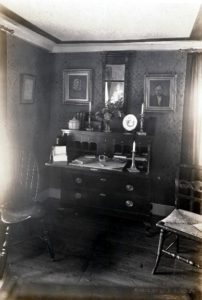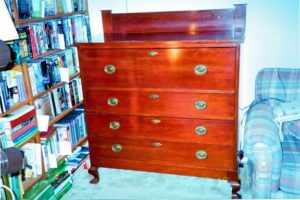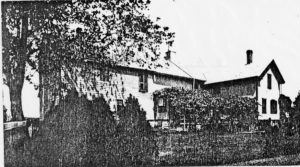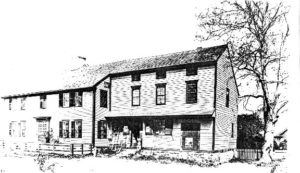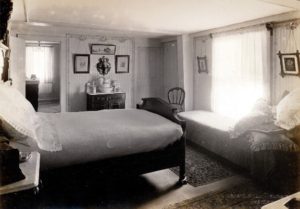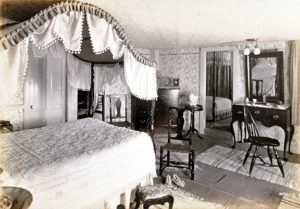By HHA Member Tom Helmer
In the eight years since discovering the Cougar, two significant events altered my perception. The first was surviving two heart attacks, which effectively ended my walking in the Valley. The second was meeting Bob Miner, who read my partial manuscript of “Walking” and invited me to take a little stroll with him, ‘cause he had something to show me. The “something” was a series of astonishing animal effigies and stone chambers made by the Indigenous peoples. The majority of us refer to the Indigenous People as “Native Americans”. Perhaps I have been learning too much from my Narragansett friends, but they make a good point: The Narragansett are Indigenous People, perfectly matching Webster’s New Collegiate Dictionary’s “definition #1: Having originated in and being produced, growing, or living naturally in a particular region or environment”. Long before Amerigo Vespucci, the Italian Navigator who loaned his name to the new continents of the “New World”, North and South America, from which the term “Native Americans” is derived. I use both terms interchangeably, but I wanted you to know that “Indigenous” has a following. But I digress.
The Narragansett artifacts I saw were so remarkable, I knew during the walk with Bob that somehow I was going to have to finish “Walking Together In Tomaquag Valley”, and expand it to include a walk entitled “Seeing The Native American Presence”. I simply HAD to teach others in that book how to “see”, just as Bob taught me. After six months of conditioning, in June of 2012 I was back at it, mapping and collecting GPS data, and writing about what I found.
 One of the things I discovered was “Turt-zilla”, an enormous turtle effigy
One of the things I discovered was “Turt-zilla”, an enormous turtle effigy
11 feet long and 9 feet wide. And a subtle feature of Turtzilla is the “low
Relief” carving and shaping of it’s stylized eye. This eye was well executed.
It opened my eyes wider to the skill the Native American sculptor brought
to his work. (How do I know a Colonial Farmer didn’t make it? Because
Colonial farmers had enough work to do just staying alive. No Colonial
would “waste time” doing something that didn’t produce food or shelter.
Turtzilla, all the other turtles, and the High Cliff Cougar are inedible!)
It was just a day or two after recognizing that there was nothing crude about the sculpting details of Turtzilla that I ran across the close up photo of the Cougar, and it hit me that maybe the Cougar was also sculpted. I called Lauri with urgency in my voice, came over to her home and punched up the close up of the Big Guy, with the now famous question: “What if it’s man made?” I have never seen Lauri just sit, silently staring at her monitor for at least 5 minutes. All the details of the next five days are in the book “Walking…”.
 Here is the first round of photographic proof that the High Cliff Cougar was made by the hand of man. In mid June, Bob Miner and I went back to the site to take some more pictures. Under the soft green light of the forest
Here is the first round of photographic proof that the High Cliff Cougar was made by the hand of man. In mid June, Bob Miner and I went back to the site to take some more pictures. Under the soft green light of the forest
canopy, the features are easy to see. I lay down and hung out over the cliff
to get this shot. When back home, I added the circles to the photo. Circles
are not a normal occurrence in nature, yet the Cougar has four different radius Arcs used in it’s precise construction. The tangential blending of the eye socket into the forehead curve is learned in a High School Geometry class today!
Few archeologists will risk the peer pressure to acknowledge the Indigenous People used Geometry, but no farmer would make the colossal effort and “waste” time making something that for him was useless. However, the Narragansett were a “Spiritual People”. The Cougar is in harmony with their theological view of the world, and for them, the monumental Cougar sculpture was part of a major Spiritual Landscape.
The next day I found a simple way to get video footage of the Cougar which I hoped would establish my belief that the Cougar WAS shaped by the hand of Man, specifically an Indigenous Person. Please follow this to the next drop down where the video recordings reveal “The Man”, and a complete circle proves the case that indeed, the High Cliff Cougar WAS shaped by the hand of man.
To give you an idea of how rare, and archeologically important Hopkinton’s Cougar is, ask yourself where the next closest Native American Monumental Cliff Sculpture is located? I’ve heard a lot of talk, but I have yet to see any documentation like what you see here. There must be more, but where are they?














